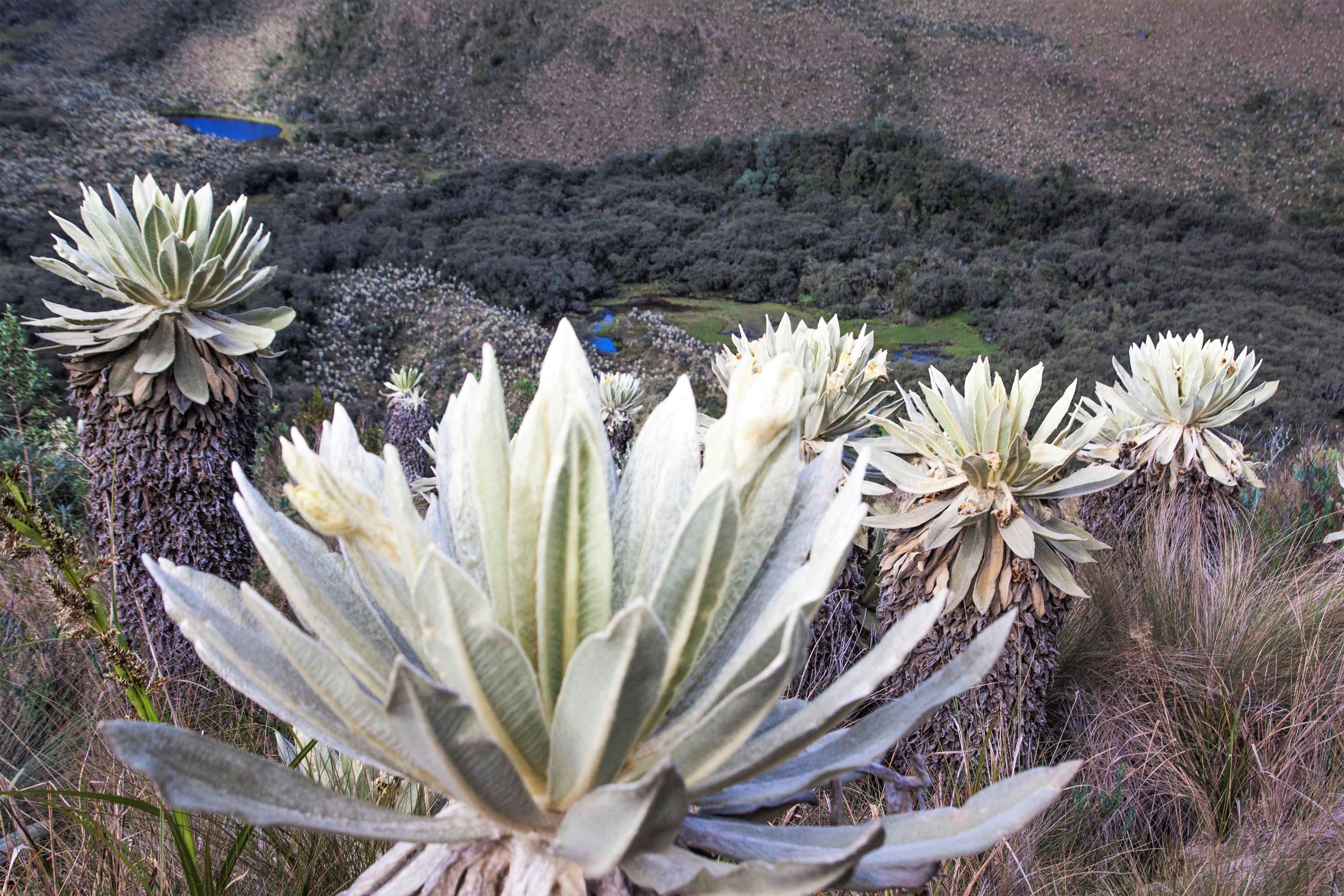Picking up on my last post on remnant natural environments surrounded (perceptually or in reality) by human-dominated landscapes, this one will look at another example—from the páramo of Northern Ecuador, where I spent a few days in June 2018.
Typical páramo landscape with frailejones.
Frailejone with bromeliad to the left. The bromeliads (genus Puya) have bright blue flowers, though I was too late in the season to catch them.
Páramo is a type of alpine moorland—cold, wet and windy—concentrated in the northern Andes above the treeline from Venezuela through Northern Peru. In parts of it the most distinguishing feature are the stands of frailejones (“friar’s ears”), tree-like members of the genus Espeletia reaching 20’ in height. Looking from a distance like giant succulents but in fact members of the sunflower family with spongy stems and soft, fuzzy leaves, these plants give the landscape a surreal and oddly animated look. (I find unbranching “trees” like these with a tuft of leaves at the top to be endearingly human-like, probably part of the reason I’m drawn to them.)
Historically the extent of the páramo ecosystem, and particularly frailejone habitat, was limited given its narrow temperature and precipitation tolerances. But today that habitat has been further reduced, and will be increasingly so, by the spread of agriculture and global warming-induced changes in temperature, rainfall and susceptibility to disease. The area that I visited, El Angel Ecological Reserve, lies between 11,950 and 15,640’ above sea level and is one of the few remaining accessible zones of frailejones in Ecuador (though there are others in Colombia and Venezuela).
View into the Reserve, overlooking the forested valley.
Inside the Polylepis forest.
I was fortunate to visit two parts of the Reserve. The first, in the area of Polylepis Lodge where I spent two nights, includes one of the last relicts of another type of ecosystem, a unique cloud forest dominated by a gnarled, orange-barked tree in the genus Polylepis. This forest filters into stream valleys like the one where the Lodge is situated, just below the páramo.
Despite the Reserve’s relatively small area, the experience of the El Angel from this accessible part at its very edge was more of butting up against civilization (in this case agriculture) rather than being surrounded by it. So the empowering feeling of being in a wilderness relict wasn’t dominant here, but the sense of the páramo rippling endlessly into the distance did reinforce the contrast between its “wildness” and the adjacent fields.
Páramo meets civilization.
The contrast was accentuated also by the mysterious and even mystical atmosphere of the landscape (which has inspired some creepy legends in local folklore), created by the shifting mists and the surreal forms and ghostly white of the vegetation. That the area supposedly also has a real element of danger—the State Department had posted an oddly specific warning about visiting the Reserve due to its proximity to the Colombian border—contributed to the slightly sinister feel, even though literally no one in the country, major tour agencies included, knew what that was about. Back home, putting the experience on paper around Halloween while listening to a “real-life” ghost stories podcast probably had a compounding effect on these impressions.
The worldview based on this part of the Reserve (entitled simply Páramo) focuses on the meeting of these wild and domesticated landscapes; I accentuate the contrast by bringing the town of El Angel right up against the Reserve despite its being some distance away by car. I also incorporate the internal contrast between the páramo and cloud forest landscapes.
Páramo, watercolor on paper, 32”x40.”
In a later post I’ll talk about the second zone that I visited (Voldero Lagoon) and the worldview it inspired, in addition to more general impressions from the trip. Even though I don’t like to focus on the “tourist” component of these experiences, I’ll end here with some tidbits about my lodging in the Reserve because it was an unexpected highlight. As the name suggests, Polylepis Lodge is nestled into the edge of the cloud forest, in the stream valley at the foot of frailejone-covered hillsides. It’s rustic yet has some touches of luxury and creative design.
Darren
The Lodge’s rustic “courtyard” with polylepis forest and páramo beyond. It has its own mini-museum of Pre-Polumbian artifacts; that’s one specimen in the center of the pool.
I was the only guest at the time (contributing to the “weirdness” factor), which meant I got a free upgrade to one of the jacuzzi rooms. The brownish stream-fed water took some getting used to.
The restaurant’s built over a canal that channels a natural stream, hence the partial glass floor.



























